Dry-Brining Is the Best Way to Brine Meat, Poultry, and More
A comprehensive guide to the salty science of dry-brining.
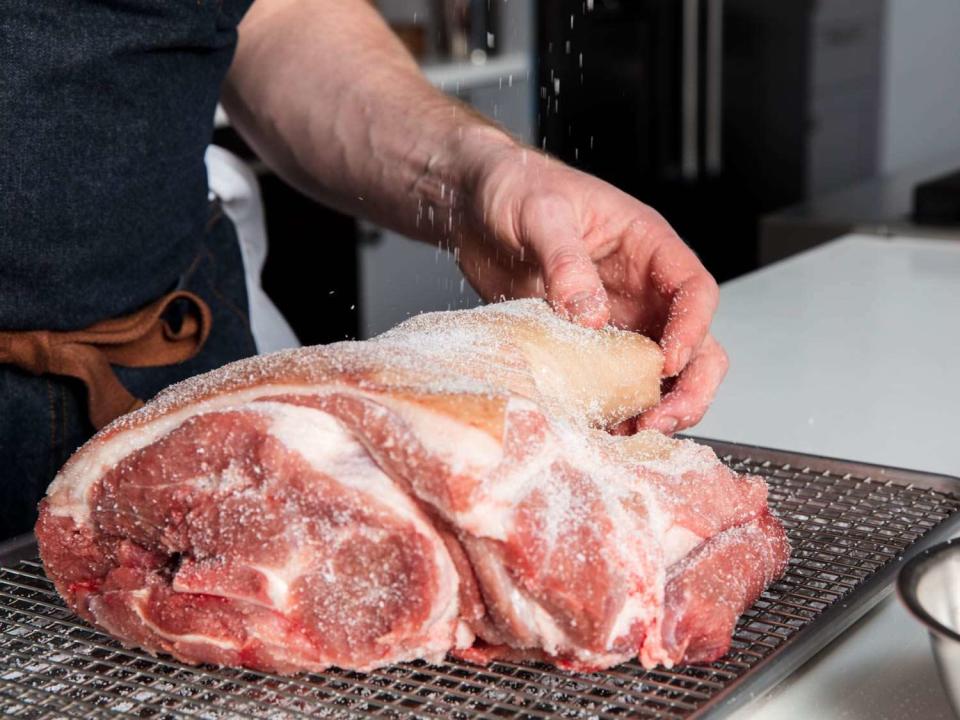
Serious Eats / Vicky Wasik
Should I brine my turkey? It's a question that comes up every year around the holidays, but that's not the only time brining is an important kitchen question, nor is turkey the only meat to which it's relevant. Here at Serious Eats we're big proponents in particular of "dry-brining," a term that always seems to elicit a lot of questions and confusion. We're here to clear things up on that topic, so that nobody gets too salty arguing with their loved ones about how to best cook a perfect roast.
Dry-Brining in a Nutshell
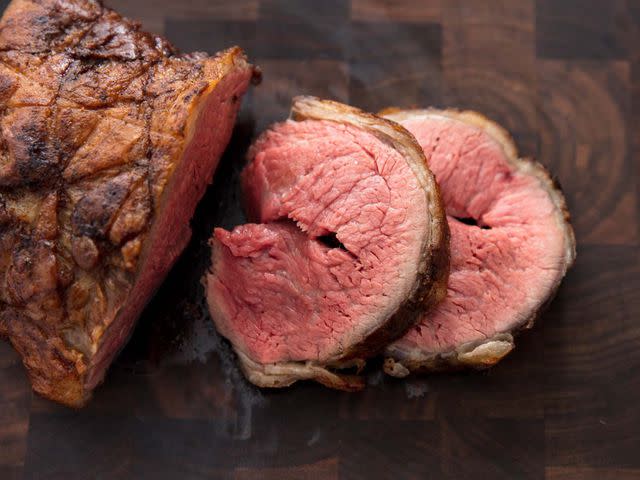
Serious Eats / Vicky Wasik
Dry-brining is a catchy term for a very simple process of salting and resting food before cooking it. Some people call this process "pre-salting," which is kind of like "preheating" an oven—doesn't make a ton of semantic sense, seeing as salting and heating are the steps, and nothing precedes them, but that's a debate for another day. Dry-brining achieves the goals of traditional brining—deeply seasoned, juicy food—without the flavor dilution problem that affects proteins brined in salt solutions.
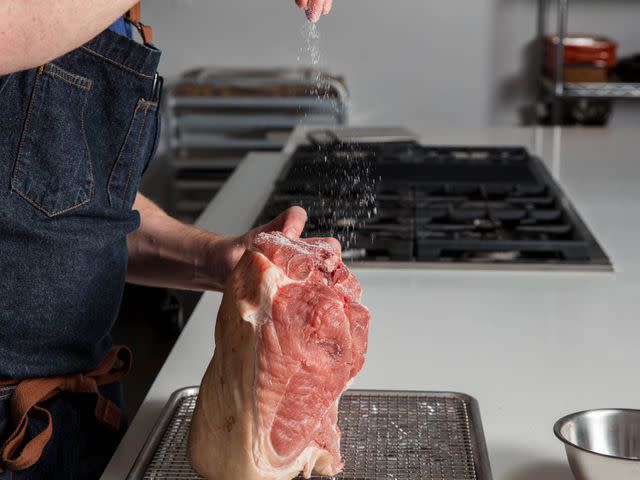
Serious Eats / Vicky Wasik
Dry-brining is our preferred method for seasoning both large and small pieces of meat, poultry, and sometimes even seafood. Along with producing juicy, flavorful results, dry-brining also helps us get better Maillard browning and crispy skin. And did we mention that it's also a much simpler process that takes up a lot less space than traditional brining projects? If you haven't tried this method before, hopefully this guide will help you make the switch to the dry side. Before we get too deep in the weeds, let's go over the basic principles of brining.
What Is Brining?
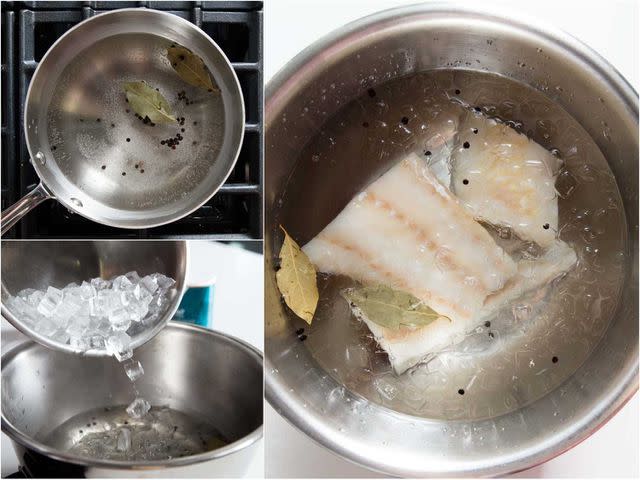
Serious Eats / Vicky Wasik
Brining is a technique used to season uncooked ingredients and keep them juicy and firm even after cooking (though not all brined foods are cooked). A brine is a salt solution, and traditional brining is done by soaking ingredients, predominantly meat or fish, in brine prior to cooking. This process is particularly beneficial for lean, relatively bland proteins like chicken, turkey, and mass-farmed pork which all have a tendency to dry out when exposed to high heat.
This dehydration happens because muscle fibers contract when heated, which squeezes out moisture like wringing out a towel. Brining helps mitigate this problem: Through the processes of osmosis and diffusion, salt and water from the brine are absorbed by the meat. Thanks to salt's ability to reshape and dissolve muscle proteins, the salt-loosened muscle fibers contract less while the salt-dissolved proteins form a gel that traps and holds onto water from the brine.* This translates to juicier meat, but that juiciness is fool's gold, as we'll see in the next section.
*This wouldn't happen if you were to soak a turkey or chicken in a plain old bucket of water; as Kenji has demonstrated, the moisture absorbed by the bird is driven out during cooking.
Waterlogged: The Biggest Problem With Traditional Brining
So you brined your bird, cooked it, sliced into it, and marveled at its juicy texture while proudly plating up portions for your guests. Then you take a bite, and another, and one more just to make sure you're not losing it, but it's inescapable that this succulent meat doesn't taste like much of anything. That's because it's watered down. By brining your turkey in a traditional wet brine, you added water that it absorbed and held onto like a vodka-soaked watermelon, but instead of a boozy fruit snack, you have a waterlogged bird that tastes...watery.
Ah, some people may say here. But if you flavor your brine with delicious things like fruit juices, stock, herbs, spices, sugar, and more, then surely your meat will be more delicious than if you just soaked it in a plain old salt-water solution. Sorry, but nope! Flavor molecules, unlike salt, are for the most part too big to penetrate the cell membranes of a piece of meat; your brine may taste flavorful, but your roast will not. (There's also a phenomenon called "salting out" that further decreases the chances those flavor molecules make it into the meat.)
We are therefore not big fans of wet-brined meat for the same reason that we are proponents of buying air-chilled chickens: More water means more dilute flavor, while less water translates to more concentrated flavor. Plus, all that extra water impedes browning, so your wet-brined roast will have a much harder time developing that wonderful brown crust and crispy poultry skin that makes a roast so good.
That doesn't mean wet brines are totally out. In some cases they're still a good choice, including fish that might benefit from a rinse (if, say, it's still fresh but has juices that are borderline smelly) or will be served raw (some sushi chefs wet-brine some types of fish before cutting and serving); fish that are going to be cold-smoked (you want to form a sticky pellicle that a wet brine helps achieve); some vegetables that salt doesn't adhere to well (whole carrots, zucchini, and asparagus); and fried chicken, where the wet brine helps form the eventual batter.
The Non-Solution Solution: The Science of Dry-Brining
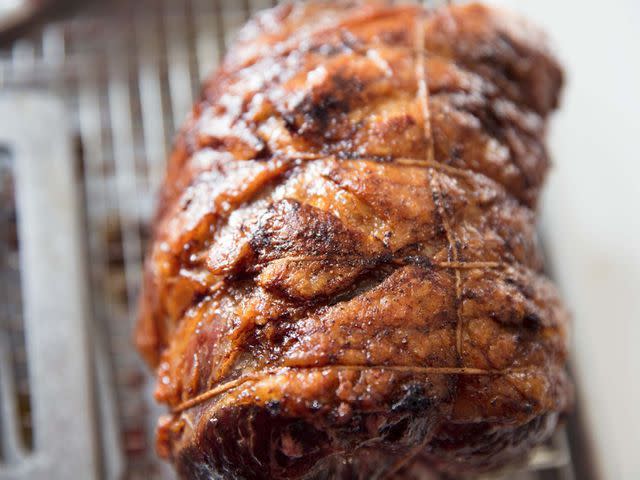
Serious Eats / Vicky Wasik
Dry-brining cuts out the unnecessary added water by using the natural moisture content of the meat to create a concentrated brine that, when given enough time, is naturally absorbed back into the meat before cooking. If you've ever made eggplant Parmesan or zucchini fritters, you know that salt draws out moisture from ingredients, and the same applies to proteins.
Season a steak with kosher salt, and within a few minutes, you will witness osmosis at work: Liquid from the steak will bead up on the surface of the meat, drawn out by the salt. Wait another ten minutes, and that liquid from the beef will have started to dissolve the salt, forming a concentrated brine. That concentrated liquid brine, formed from the meat's natural juices, is what makes this process "brining" and not just a ridiculous rebranding of mere salting.
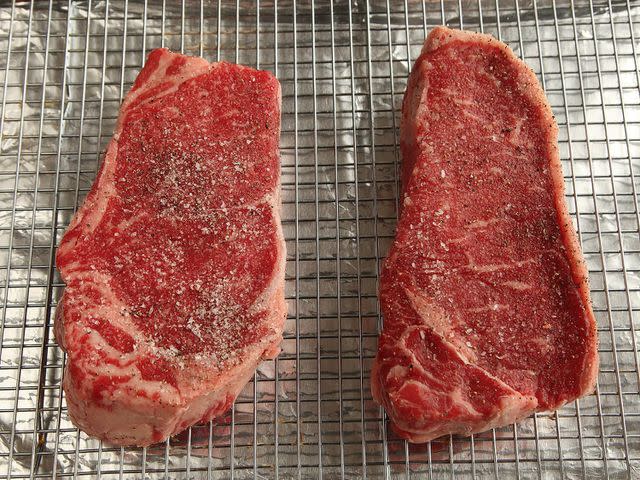
Serious Eats / J. Kenji López-Alt
That dissolved salt is then absorbed by the meat through diffusion, moving from an area of high concentration (the surface of the steak) to a lower concentration one (the steak's interior). As with a traditional brine, the salt re-shapes and dissolves muscle proteins, allowing the meat to absorb and retain moisture.
To complete the dry-brining process, the moisture that was initially drawn out of the meat is reabsorbed to counteract the shift in salt concentration from surface to interior, leaving you with a well-seasoned piece of meat that will now better retain its natural moisture content during cooking. You're tricking your food into brining itself with its own juices, and all it takes is some salt and a little patience.
The Benefits of Dry-Brining
Still unconvinced about the merits of dry-brining? Or do you need to state your case to a stubborn friend or family member who insists on splashing around with a salt-water-bathed turkey every year? Here are the bullet points in favor of dry-brining.
Easy and Space-Saving
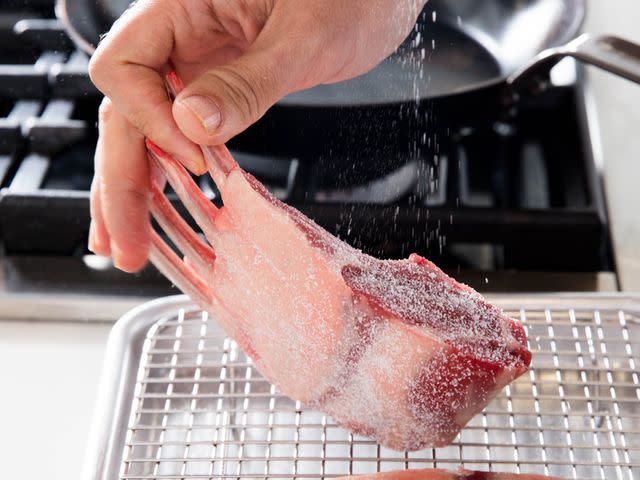
Serious Eats / Vicky Wasik
Traditional wet-brining is a logistical nightmare when you're working with something as big as a turkey. Who has giant food-safe buckets kicking around for plunging a bird into? Or the fridge space to keep the soaking turkey cold for a few days? And if you decide to brine in a giant cooler, do you really want to spend a good portion of a morning painstakingly sanitizing it once the brining is done so that you don't end up serving salmonella sodas at your next cookout?
Then there's the making of the brine itself. Having to whisk and whisk and whisk to dissolve a bunch of salt (how much was it again?? Did I get that ratio right?) in cold water, or heating up a batch of brine on your stovetop to then have to wait while it cools down before using it, all the while taking into account displacement for when the turkey gets added to the bucket and so on. With dry-brining, all you have to do is Salt Bae that sucker up on a wire rack–lined baking sheet, and pop it in the fridge. So much simpler.
The wire rack, by the way, is important: You want air to circulate fully around the meat and not have it sitting in a puddle of its own juices.
More Deeply Seasoned Food, Without Fuss
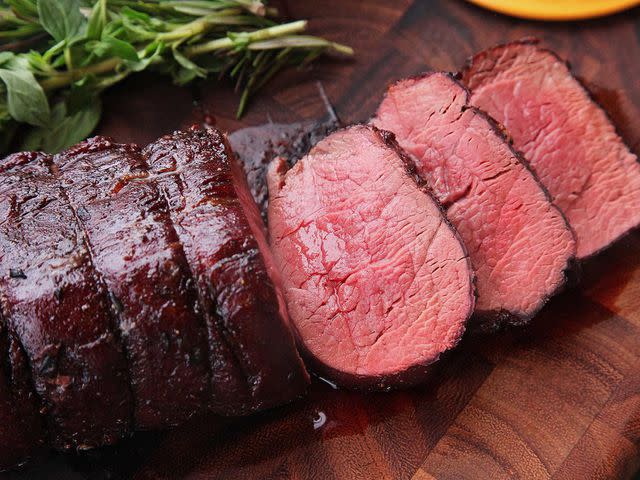
Serious Eats / J. Kenji López-Alt
As mentioned above, traditional brines chock-full of aromatics smell nice and all, but those flavors, beyond the salt in the solution, are not transmitted to the meat. Simply sprinkling your food with salt and giving it time to do its work creates much more evenly and deeply seasoned meat than the surface-level flavor you get from salting right before cooking.
Undiluted Flavor
As mentioned earlier, dry-brined meats and fish taste more of themselves than they do when wet-brined because they aren't holding onto extra water weight, which dilutes flavor. Just as you wouldn't be thrilled about getting a bland, watered-down cocktail at a bar that touts the skills of its head "mixologist," you shouldn't serve people waterlogged turkey or chicken.
Juicy, Firm Results
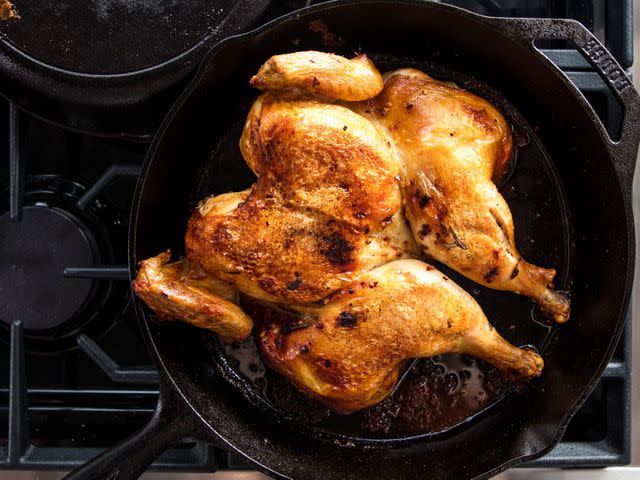
Serious Eats / Vicky Wasik
Dry-brined meat and fish comes out perfectly juicy and firm after cooking. Given time, salt will perform its protein-dissolving magic, which allows meat to hold onto its natural moisture during cooking. For soft-fleshed fish like mackerel, salting also helps firm up the meat, making it both easier to maneuver during cooking and more pleasant to eat.
Better Browning and Crispier Skin
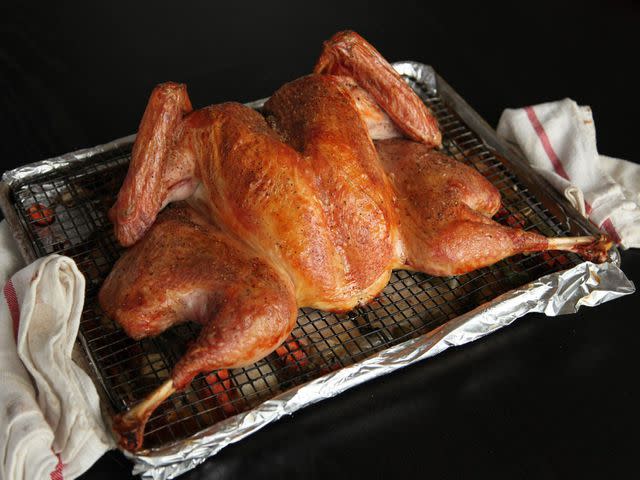
Serious Eats / J. Kenji López-Alt
Along with producing juicier meat, dry-brining also helps achieve better surface browning, crunchier crust on steaks and beef roasts, and crispier poultry and pork skin. Once the moisture that initially beaded up on the surface of the meat is drawn back in to balance the high salt concentration of the interior (and also evaporates off it), the meat's surface is left much drier than before.
And because the moisture in the meat isn't being squeezed out as much, thanks to the proteins dissolving and muscle fibers relaxing, the surface of the meat stays drier during cooking. Dry surfaces brown, wet ones don't. So when you blast a dry-brined piece of meat with heat, whether searing in a skillet or finishing in a hot oven, you achieve Maillard browning really fast, which means you're less likely to overcook your food in the quest for a mahogany crust.
And the same goes for crispy, crackly skin, which needs to be nice and dry before it can get to that stage. A dry brine can get you the bronzed, crunchy chicken and turkey skin you've always dreamed of. Traditional brine just won't, and you'll be left with pale, soft, and flabby skin instead. To produce extra-crispy poultry and pork skin, we like to mix in a little baking powder with the kosher salt, which gets sprinkled over it.
The slightly alkaline baking powder raises the skin's pH levels, which allows proteins to break down more efficiently, giving you crisper, more evenly browned results. Simultaneously, it combines with the bird's natural juices, forming carbon dioxide gas that leaves you with a layer of tiny bubbles. It's these bubbles that increase the skin's surface area, allowing it to develop a crunchy texture once cooked.
The Guiding Principles of Dry-Brining
Hopefully, you're now on board with this whole dry-brining game and are ready to give it a shot. Before you do, here are some general guidelines to follow for dry-brining projects.
Use Kosher Salt, Preferably Diamond Crystal
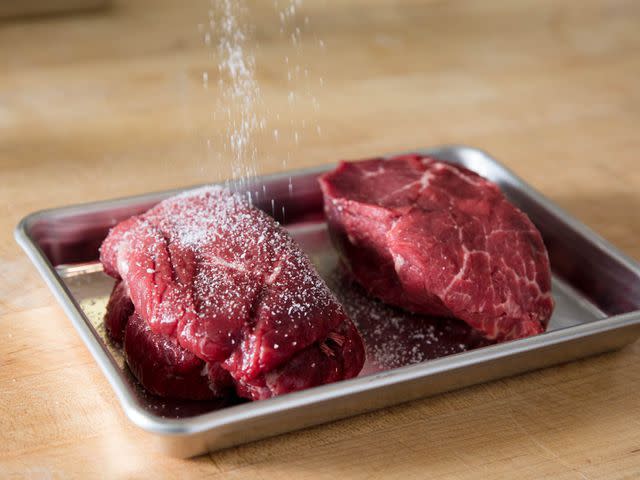
Serious Eats / Vicky Wasik
Kosher salt is a must for dry-brining because its texture makes for easy sprinkling and doesn't clump like table salt. All of us on the Serious Eats culinary team favor Diamond Crystal brand kosher salt as our basic kitchen salt.
When seasoning for dry-brining, season from up high, around eight to ten inches above the food, letting the salt granules fall evenly over the surface of your food. Season the entire surface of the food that is being treated, on all sides—top, bottom, edges, and in those pesky crevices some roasts like birds have between the wings and breast.
We generally don't call for a precise amount of salt for sprinkling over a piece of meat because it's impractical: If a recipe calls for two teaspoons of salt to be sprinkled over a chicken, it's a pain in the butt to measure out and evenly distribute those two teaspoons.
It's much more practical to learn how to season evenly on your own without a prescribed amount of salt. Practice grabbing hefty three-finger pinches of salt and letting them fall evenly through your fingers. If you want to be wicked smaht about it, practice grabbing three-finger pinches of salt, and then weigh those on a very sensitive scale to get a sense of how much you are grabbing at a time. This will allow you to more easily quantify the amount of salt you use during cooking without having to bust out the measuring spoons every time.
The amount of salt you use for dry-brining is correlated to the size of the food you are cooking. While you always want to season with an even amount of salt on all surfaces, you want to take a lighter seasoning touch with a 6-ounce fish fillet than you do with a 12-pound standing rib roast. This means for big roasts, salt it like you salt your driveway in the winter (don't want to hear it, California people, we know you don't get snow).
Give It Time
Once you've salted your meat, you need to give the salt time to do its thing. The worst thing you can possibly do is try to rush a dry-brining project. If you try to cook a steak that you've salted before the moisture on the surface has dried, you're going to end up steaming the surface of the meat initially, preventing good browning from happening.
Smaller cuts of meat like steaks and thick white fish fillets need to be either cooked immediately after seasoning (which means you won't get any of the benefits of dry-brining) or allowed to sit for at least 45 minutes after seasoning before they can be cooked; you'll know they're ready when the surface is dry. Rest food, uncovered on a wire rack set inside a rimmed baking sheet, popping items in the fridge that you don't plan on cooking right away once those 45 minutes are up.
Let Big Proteins Chill: Rest and Refrigerate Uncovered
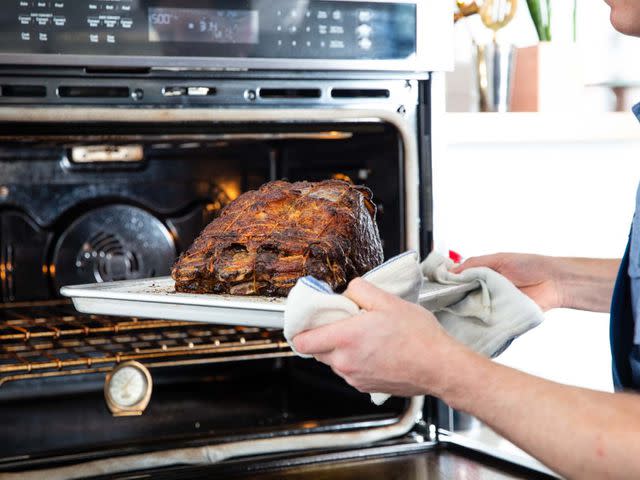
Serious Eats / Vicky Wasik
Larger format proteins like roasts, whole chickens, and turkeys need to rest even longer after salting in order to achieve all of the benefits of dry-brining. We recommend letting these items rest at least overnight in the fridge if at all possible. Again, place them on a wire rack set inside a rimmed baking sheet and refrigerate uncovered.
Don't Rinse It Off
Once the dry-brining waiting period is up, there is no need to rinse off the surface of your food. The meat will not be overly salty, and rinsing the surface with water will undo all of the surface-drying achieved by the dry-brine process. That, in turn, will prevent browning.
We Can Dry-Brine That: Foods That Benefit From Dry-Brining
So what foods can benefit from dry-brining? So many! Here's a quick rundown of some of our favorite candidates for this method.
Birds: Turkey, Chicken
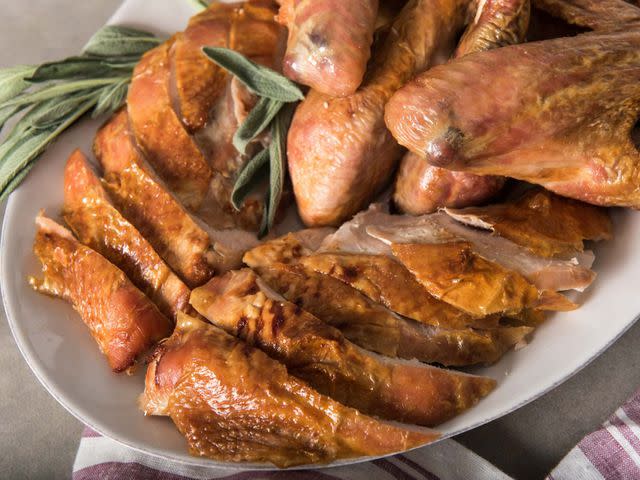
Serious Eats / Liz Clayman
We love a dry-brined roast turkey or roast chicken. A dry brine can be simply sprinkled over the entire surface of a whole bird (including inside the cavity or on the underside of a spatchcocked bird); you can also season under the skin, but it's a little messier and harder to achieve even seasoning. If you are seasoning under the skin or if you're brining directly onto the flesh of a skinless piece of chicken, such as a cutlet, we recommend a basic kosher salt dry brine. If seasoning the skin, use the kosher salt–baking powder mixture (1/2 cup kosher salt to 2 tablespoons baking powder) for optimal browning and crisping.
Dry-Brine Type: Kosher salt if seasoning under skin. Kosher salt–baking powder mixture if seasoning skin.
Refrigerated Resting Time: At least 12 hours and up to 3 days.
Large Roasts: Prime Rib, Pork Shoulder, and More
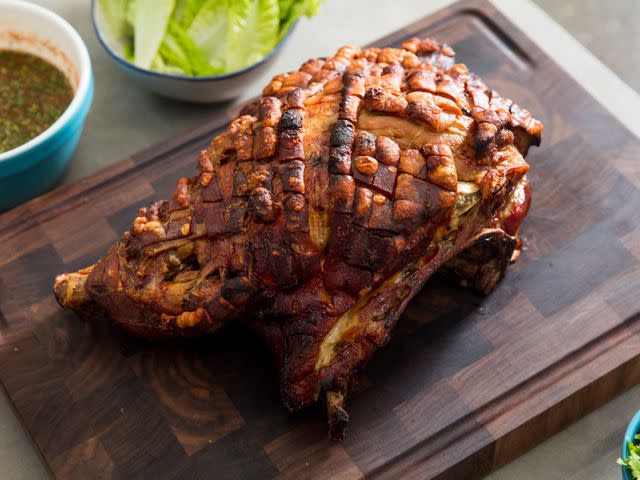
Serious Eats / Vicky Wasik
Big hunks of meat are perfect candidates for dry-brining. Whether you are cooking an expensive prime rib, whole beef tenderloin, a more affordable tri-tip roast, or a Thai-inspired slow-roasted pork shoulder, dry-brining will get juicy, well-seasoned meat, with excellent surface browning. As with whole birds, plan to season a day ahead of time and rest the roast overnight in the fridge.
Dry-Brine Type: Kosher salt for any roast that doesn't have skin that you want to crisp up. Kosher salt–baking powder mixture for roasts with crackling skin.
Refrigerated Resting Time: At least 12 hours and up to 3 days.
Smaller Cuts: Steaks, Chops, Racks
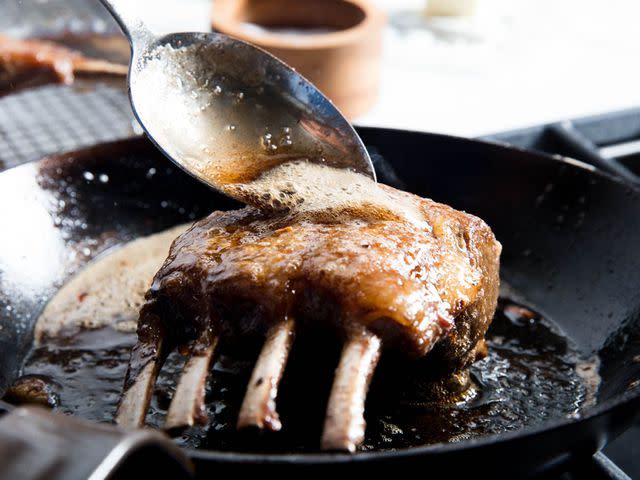
Serious Eats / Vicky Wasik
Dry-brining also works wonders on smaller cuts of meat like steaks, pork chops, and racks of lamb. Their smaller size allows for a shorter resting period. Allow smaller cuts to rest for at least 45 minutes before cooking—basically enough time for the surface to dry. You can rest meat at room temperature if you're going to cook it right after those 45 minutes are up, otherwise rest it in the fridge.
Dry-Brine Type: Kosher salt
Resting Time: At least 45 minutes and up to 24 hours in the fridge.
Fish
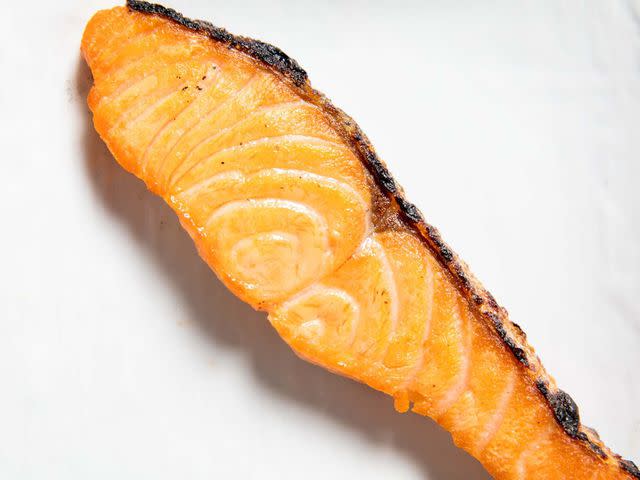
Serious Eats / Vicky Wasik
Along with meat, you can also dry-brine thick fish fillets before cooking. For thick, firm-fleshed white fish fillets, sprinkle them with a mixture of kosher salt and sugar (2:1 salt to sugar by weight), and rest for 45 minutes and up to 90 minutes in the fridge before cooking (resting the fish longer than that will give it a more cured texture). This dry brine firms up the fish, seasons it deeply, and keeps it juicy during cooking, while the sugar helps ensure the fish doesn't end up being overly salty. For a saltier, more cured piece of fish, try Sho's Japanese-style salted salmon, which is salted for at least 12 hours before being broiled.
Dry-Brine Type: Kosher salt-sugar mixture for firm-fleshed white fish fillets. Kosher salt for Japanese-style salted salmon.
Refrigerated Resting Time: At least 45 minutes and up to 90 minutes for thick white fish fillets. At least 12 hours and up to 36 hours for Japanese-style salted salmon.
Vegetables: Sauerkraut and Other Lacto-Fermented Vegetables
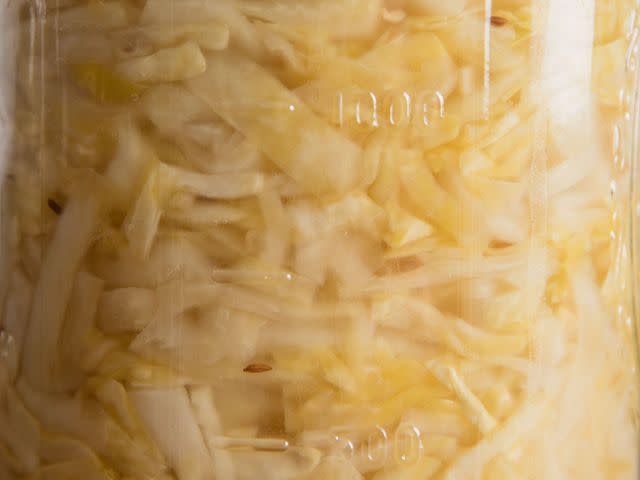
Serious Eats / Vicky Wasik
I would be remiss to go through this whole dry-brining guide without acknowledging that vegetables can be given this treatment as well, even if it's usually not in the context of seasoning before cooking. Lacto-fermented vegetable recipes like traditional sauerkraut are essentially dry-brined! Shredded cabbage is mixed with salt, which draws out moisture, and that liquid eventually becomes the "brine" that helps lead to funky, fermented kraut. Who says meat should get to have all the dry-brining fun?
One Thing You Definitely Shouldn't Dry-Brine: Burgers
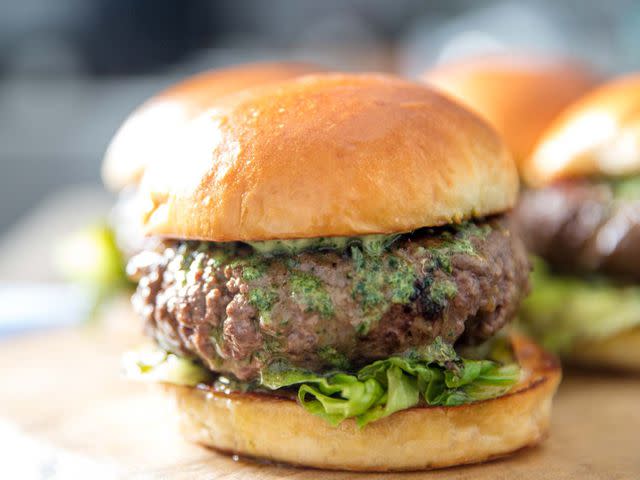
Serious Eats / Vicky Wasik
Finally, there are some foods you definitely don't want to dry-brine, and burgers are number one on that list. Kenji wrote about this a decade ago (!!), so it's worth reminding everyone: Do not salt ground beef for burgers ahead of time.
Only season right before cooking. Why? By now it should be drilled into you that salting meat dissolves proteins, forming a sticky gel that helps retain moisture. That's all well and good for whole muscles, but not so great for ground meat, unless you're making sausages, meatloaf, and other forcemeats. Sticky ground meat has a bouncy texture when cooked, which is perfect for certain kinds of sausage, not so much for a burger that should have a loose and coarse texture. Don't dry-brine your burgers.
December 2019
Read the original article on Serious Eats.

